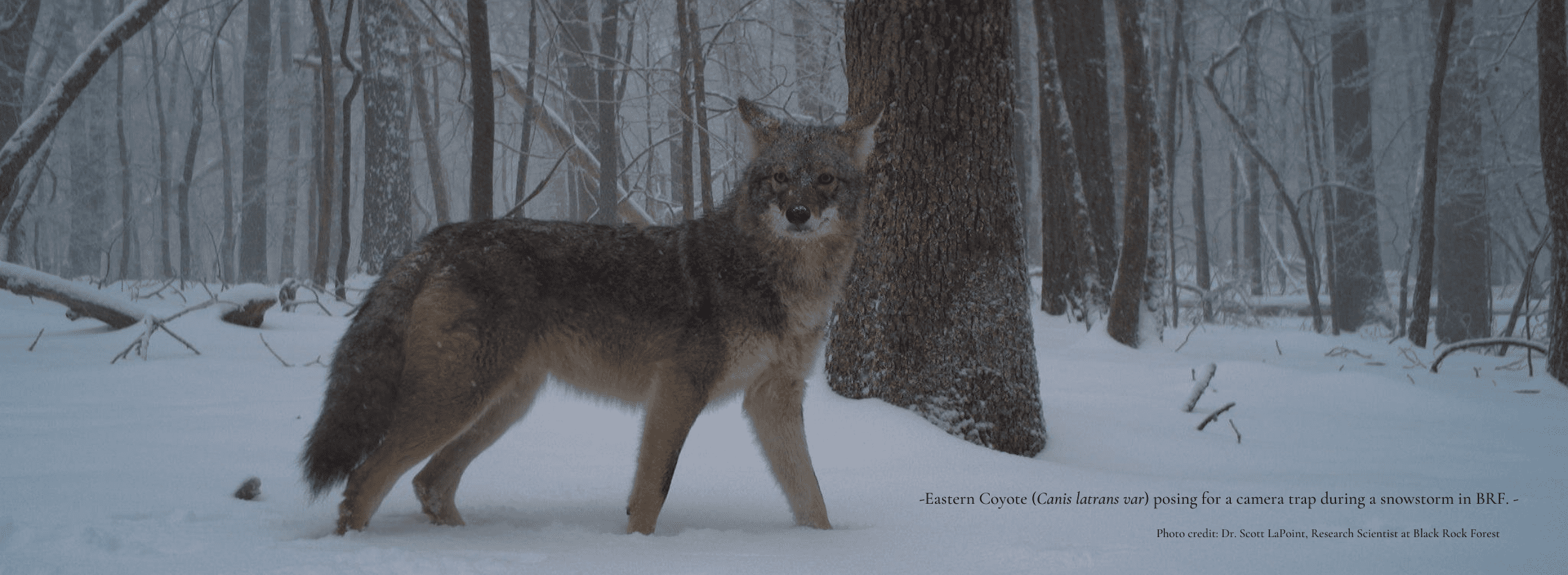While the eastern coyote (Canis latrans var) has been present in New York state since the 1930’s, their population has increased significantly over the past 50 years. The canine’s ability to adapt, locate food sources, and reproduce has allowed them to become one of the top predators in the state. Their population and impact here in Black Rock Forest has been documented by Forest managers annually since the late 1980’s.
After a fresh blanket of snow on the Forest floor, BRF staff head out to conduct winter deer tracking efforts. These tracking efforts allow us to gather data on the number of deer using the Forest, determine what food sources the deer are utilizing, and assess the overall health of the deer population over winter. But what does this have to do with coyotes you might ask? Well, it turns out that these efforts also provide an in depth look at our coyote population and their winter behavior in BRF. You would be hard pressed not to encounter a set of coyote tracks in the snow on just about any trail or road throughout BRF. Coyotes use the Forest trail and road network to efficiently traverse the landscape, often leaving behind many clues to their behavior. They communicate through scent marking, with both skat and urine, which is deposited at frequented locations, often atop rocks and downed logs along or at the intersection of trails. Coyotes also communicate verbally through a variety of vocalizations including howling, yipping, barking and everything in between. This complicated chorus of sounds often leads people to believe that coyotes gather in large groups to howl, however this usually is not the case. Coyotes typically travel in pairs and the occasional group of 3-4, behavior which has been supported by both tracking and camera trap data. The availability of resources and their territorial behavior limits their populations in one specific area like BRF.
While most species are doing what they can to survive, the coyotes appear to flourish during the winter months. Coyotes are opportunistic predators that can cover up to 10 miles per day searching for food sources ranging from small mammals and rodents all the way up to adult whitetail deer. It is believed that a large part of their winter diet is comprised of deer especially after snow covers the Forest floor. Once a crust has formed on top of the snowpack, coyotes have a significant advantage over deer whose hooves pierce the ice layer at the top of the snowpack and slow them down. Coyote’s ability to walk and run on top of the snow allows them to pursue and single out weak or previously injured deer. Part of our winter tracking efforts include locating deer depredated by coyotes, which gives us an opportunity to assess the overall health of our wintering deer population via bone marrow analysis. BRF staff extract a bone marrow sample from the femur and analyze the color, which is used to determine the level of fat stores remaining at the time of harvest. These coyote harvests are another tool Forest managers use to assess the effectiveness of forest management practices.
The coyote’s ability to adapt to constantly changing habitats and coexist with human disturbance has made them a valuable species to learn from here in the Forest. BRF continues to collect data and make inferences about their impact on the Forest for future generations. As you walk the trails this winter, take note of the clues left behind by these canines and their role in this complex ecosystem.
Aaron Culotta
Environmental Educator
Black Rock Forest
Photo: Dr. Scott LaPoint, Research Scientist at Black Rock Forest
Eastern Coyote (Canis latrans var) posing for a camera trap during a snowstorm in BRF.

